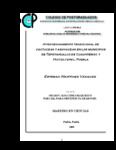Aprovechamiento tradicional de cactáceas y agaváceas en los municipios de Tepeyahualco de Cuauhtémoc y Huitziltepec, Puebla
Abstract
Las cactáceas y agaváceas son dos familias botánicas de gran importancia por el número de especies que presentan, y por los múltiples usos que han tenido entre la población de México. En los municipios de Tepeyahualco de Cuauhtémoc y Huitziltepec, diversas especies de cactáceas y agaváceas se han utilizado desde tiempos inmemoriales, con lo que se han generado importantes conocimientos sobre su manejo, producción y reproducción, aunque en la actualidad existen factores que están interfiriendo en el proceso de transmisión de éstos, lo cual amenaza la reproducción de los agroecosistemas y vulnera la diversidad de distintas especies de estas plantas. Este trabajo tuvo como objetivos registrar y sistematizar el conocimiento tradicional que aún mantienen los habitantes de éstos municipios en el uso, manejo y conservación de las cactáceas y agaváceas, además de Identificar taxonómicamente las especies útiles de éstas y, plantear con ello estrategias de desarrollo para dichos municipios. Se realizaron recorridos de campo y aplicaron entrevistas a una población muestra de 51 personas seleccionadas de manera intencional a través de la técnica “bola de nieve”, encontrando muchas especies de cactáceas que son aprovechadas, entre ellas, según su orden de importancia están la pitaya (Stenocereus pruinosus), xoconochtle (S. stellatus), pitahaya (Hylocereus undatus), maguey cimarrón (Agave salmiana Var. ferox) y xilometl (A. americana y A. atrovirens) utilizadas principalmente para barbacoa y pulque, respectivamente. Se encontraron prácticas locales encaminadas a conservar la diversidad de las huertas de pitaya, donde se llegaron a encontrar más de 15 especies y variedades de plantas que son aprovechadas. Las tecintas son otras prácticas culturales con una importante función en la conservación de suelos de los agroecosistemas._______Due to their manifold applications and number of species present, cacti and agaves are two botanical families of great importance to Mexico’s population. Since time immemorial, in the municipalities of Tepeyahualco de Cuauhtémoc and Huitziltepec, various species of cacti and agaves have been utilized, resulting in the generation of important understandings related to management, production and reproduction of these plants; albeit factors exist that interfere with the transmission process and threaten reproduction of the agricultural ecosystem, making the diversity of distinguishing features of species of these plants vulnerable. The objective of this study was to register and systemize the traditional knowledge that the inhabitants of these municipalities maintain with respect to use, management and conservation of the cacti and agaves, as well as taxonomical identification of the useful species to explain growth and development strategies for said municipalities. Field studies and interviews were conducted using the snowball technique to select a sample population of 51 individuals, results show many species of cacti of which good use is made, among them, and ranked by importance: the pitaya (Stenocereus pruinosus), xoconochtle (S. stellatus), pitahaya (Hylocereus undatus), maguey cimarrón (Agave salmiana Var. ferox) and xilometl (A. americana y A. atrovirens) principally used for barbecuing and the making of pulque, a fermented milky drink, respectively. Found were local practices and cultural applications aimed at conserving the diversity of the pitaya orchards, where more than fifteen species and varieties of plants are utilized, and the use of the tecinta, a type of stonewall designed to conserve the soil of the specific agro ecosystem.
Collections
- Tesis MC, MT, MP y DC [398]


